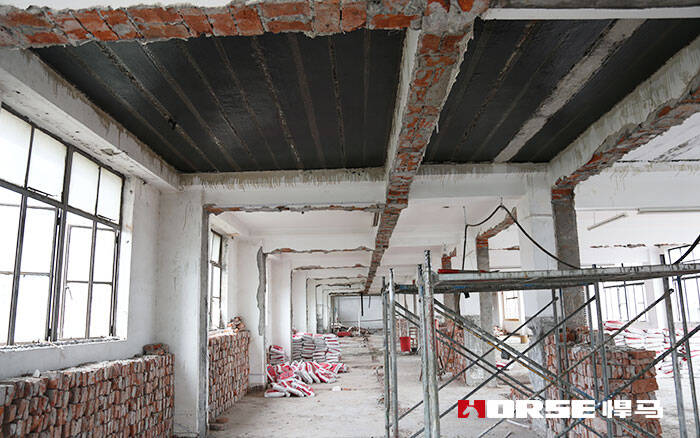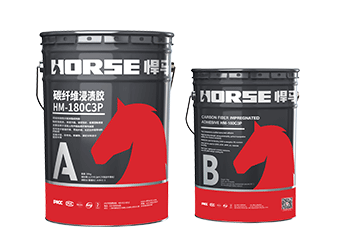Solutions
Horse Construction offers full range of structural strengthening materials with technical supports, documentation supports, products supports, project supports.
Standard construction flow chart and practice of masonry structure strengthened with carbon fiber reinforced polymer(CFRP) sheet

I. General Provisions
1) construction should follow the following procedures:
1. construction preparation;
2. masonry surface treatment;
3. leveling;
4. brushing the base glue.
5. brushing glue or impregnation.
6. paste fiber sheet;
7. surface protection.
2) The adhesive should be weighed according to the prescribed proportion in the product instructions and stirred evenly with a stirrer until the color is uniform. Oil and impurities should not be used in mixing containers and agitators.
[Note] Oil contamination and impurities will affect the performance of the adhesive, and attention should be paid to the cleaning of mixing containers and agitators. At present, the adhesives for strengthening engineering structures in the market are mainly composed of two components in a certain proportion or a single component. Therefore, the adhesive should be prepared according to the instructions provided by the supplier.
3) the construction temperature should comply with the requirements for the use of the complete adhesive.
4) the environmental humidity should not exceed 70% during construction.
[Note] In order to ensure the quality of the adhesive, the ambient temperature of the construction site must be in line with the use temperature of the adhesive. If it can not be satisfied, measures must be taken to make it meet the requirements and paste again.
5) when the fiber sheet is pasted, the construction time should be controlled according to the requirement of the adhesive.
6) the bending of fiber sheets should be avoided during construction.
During the construction process, the bending of fiber sheets will affect the stress transfer, thereby affecting the reinforcement effect. Therefore, the bending of fiber sheets should be avoided during construction.
2. Construction
1)carbon fiber fabric and bonding material
[Explanation] With the development of fiber production technology, the mechanical properties and quality of fiber sheets have been improved day by day, and the types of reinforcement fibers are also increasing. In order to make better use of this kind of material, the certificate and test report of fiber sheet and adhesive products should be checked before reinforcement, and the difference between the design and the actual reinforcement materials should be avoided.
Unsaturated polyester resin, alkyd resin and other adhesives shall not be used in masonry structure reinforcement works. The base glue should be suitable for impregnating glue and adhesive.
2) it is advisable to remove the live loads on the structure before reinforcement.
The load on the reinforced structure has certain effect on the reinforcement effect. Therefore, it is advisable to remove the live loads acting on the structure before reinforcement.
3) the surface treatment of masonry should comply with the following requirements:
1. The plastering layer of the reinforced masonry structure should be cut off. When the worsening phenomena such as weathering, loosening and corrosion occur on the surface of the masonry, the plastering layer should be removed.
2. when cracks or holes exist in reinforced masonry, cracks should be designed or closed for design.
3. the masonry surface should be cleaned and kept dry.
[Note] In order to ensure the reliable bond between masonry structure and fiber sheet, the plastering layer on the surface of masonry and the places where weathering, loosening and corrosion occur should be removed before the fiber sheet is bonded. At the same time, in order to avoid the secondary cracks caused by the cracks in the reinforced masonry, it is necessary to grout or seal the cracks in the reinforced masonry.
4) the leveling of masonry surface should comply with the following requirements:
1. leveling materials should be provided according to the performance requirements specified in the national standard.
2. the leveling material is used to fill up the gray joints and surface concave parts of the masonry without any edges and corners.
5) the undercoating should meet the following requirements:
1. the adhesive should be prepared according to the instructions of the product, and its performance should conform to the requirements of Figure 3.
2., the surface of the leveling material should be dry and brushing.
3. roller brush or brush should be used to spread the base glue evenly on the masonry surface. The surface of the base glue should be adhered immediately after drying.
Gelatin refers to the state of reaching the gel just now, that is, there is gel sensation on the surface of the glue on the construction site, but it will not stick to the glue.
6) the adhesive fiber cloth should be carried out according to the following procedures and requirements:
1. fiber cloth should be cut according to design size.
2. it should be prepared and impregnated evenly in the reinforcement area.
3. When pasting fiber cloth, special drum should be used to roll along the fiber direction for many times to extrude bubbles, so that the impregnated adhesive is fully immersed. Rolling should be rolled from one direction in sequence or from the middle to both sides, and the fiber should not be damaged.
4. When pasting multi-layer fiber cloth, repeat steps 1-3 and paste the next layer immediately after the surface of the fiber cloth is dried by dipping adhesive.
5. evenly spread impregnating glue on the surface of the last layer of fabric, and there must be no leakage or no fullness.
[Note] The impregnating adhesive is used to fix the fibre sheet on the same plane, protect the fibre sheet and force the fibre together. Therefore, it should be fully immersed in the fibre sheet. When the special roller is used to roll the fiber sheet, it can roll in one direction or two directions from the middle, but it is not allowed to roll back and forth repeatedly to avoid damaging the fiber and affecting the sticking quality.
The bonding effect is the best during the next step construction from the surface of the impregnated adhesive to the full curing period, and the fiber sheet can also be bonded after the impregnated adhesive is completely cured when there is a test basis.
The impregnated glue can be applied evenly on the surface of the last layer of fiber cloth to ensure that the impregnated glue is fully impregnated into the fiber sheet.
7) sticking fiberboard should be carried out according to the following procedures and requirements:
1. cutting fiberboard according to design size;
2. When the surface of the fiberboard is not roughened, the adhesive surface of the fiberboard should be roughened.
3. Fiberboard adhesive should be prepared and applied; Fiberboard adhesive surface should be wiped clean, and immediately coated with prepared fiberboard adhesive, adhesive layer should be convex, minimum thickness should not be less than 2 mm;
4. Fiberboard coated with adhesive should be lightly pressed and glued to the designed adhesive position. Rubber roller should be used to roll evenly along the fiber direction, and should ensure compactness.
5. when sticking two layers of fiberboard, continuous paste should be adopted. Both sides of the bottom fiberboard should be rough and wipe clean. When the next layer of fiberboard can not be immediately pasted, the bottom layer of fiberboard should be re-cleaned before starting to paste the fiberboard.
To ensure the reinforcement effect, the fiberboard should be cut according to the design size. The cutting tools can be made of hacksaw, grinding wheel or disc diamond cutter. Plates should not overlap and overlap, so the actual length should be determined before cutting to avoid material waste.
The surface of the fiberboard is clean and the adhesive is uniform and abundant, which can ensure the bonding quality. When two layers of fiberboard are bonded, the two sides of the bottom fiberboard are roughened to ensure the bonding quality.
8) The surface protection shall be carried out after the bonding fiber sheet is completed and the bonding material is completely solidified. The surface protection construction shall conform to the relevant provisions of GB 50212, the current national standard for construction of anti-corrosion engineering, and the reliable bonding between the protective material and the fiber sheet shall be ensured.
[Explanation] Surface protection is to protect the fiber sheet and adhesive of the reinforced masonry structure from the harmful environment. Corresponding protective measures should be taken for masonry structures with protective
3. Construction safety
1) raw materials for fiber sheet adhesive should be sealed and stored away from fire sources to avoid direct sunlight exposure.
2) the preparation and use of adhesives should be well ventilated.
3) site workers should take labor protection measures.
4) When CFRP is used in reinforcement construction, it should be far away from electrical equipment and power supply or take reliable protective measures.
You can find anything here you are in need of, have a trust trying on these products, you will find the big difference after that.

High strength, unidirectional carbon fiber wrap pre-saturated to form a carbon fiber reinforced polymer (CFRP) wrap used to strengthen structural concrete elements.

Good impregnation carbon fiber adhesive for applying carbon fiber reinforced polymer(CFRP) wrap for structural strengthening

High strength carbon fiber reinforced polymer (CFRP) strip / laminate / plate for structural strengthening and concrete repair